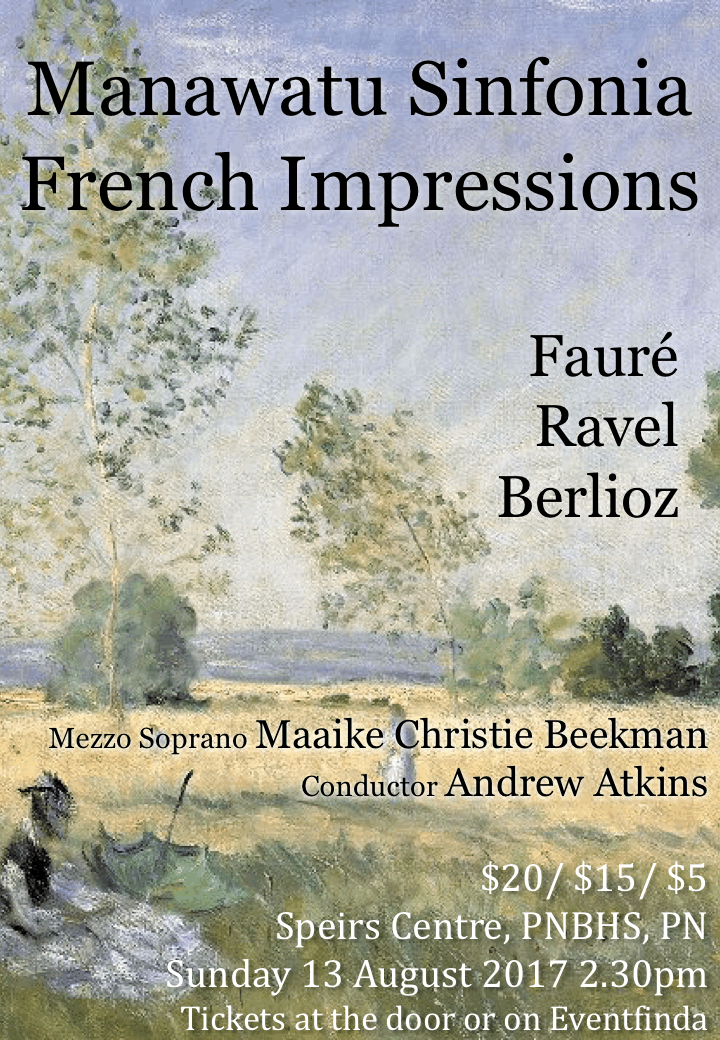Manawatu Sinfonia 13 August 2017


Sunday Aug 13th 2.30pm.
Speirs Centre, PN Boys High School, Featherston Street (opposite Mega Mitre 10).
Conductor: Andrew Atkins.
Soloist: Maaike Christie Beekman.
Concert with a French theme:
Fauré - Pavane, op. 50
Berlioz - Les Nuits d'été, with mezzo-soprano solo
Ravel - Pavane pour une infante défunte
Ravel - Ma Mère L’Oye
GABRIEL FAURÉ (1845 – 1924), Pavane in F-sharp minor for orchestra, Op. 50
Not as famous internationally as his teacher Camille Saint-Saëns or his pupil Maurice Ravel, Gabriel Fauré produced relatively few large-scale compositions. He was already too busy as chief organist at the Madeleine, director of the Paris Conservatory, a critic for Le Figaro, and president of various musical associations. He was also a frequenter of Parisian salons, finding his way into the pages of ‘A la recherche du temps perdu’ (Remembrance of Things Past) by his friend and admirer the novelist Marcel Proust, who alludes to him in passages such as ‘Le style rapide, anxieux, charmant avec lequel M. de Charlus jouait le morceau schumanesque de la Sonate de Fauré’ (The rapid, anxious, enchanting style in which Monsieur de Charlus played the Schumannesque passage of Fauré’s Sonata). Among Fauré’s acquaintances and patrons was Élisabeth de Caraman Chimay, Countess Greffulhe, ‘the undisputed queen of Parisian society’. To her the Pavane is dedicated. Originating as a piano piece, written for a popular concert series in 1887, it was reissued by Fauré in an orchestrated version with optional part for (invisible) chorus in 1888. The intimately scored piece begins serenely with a haunting flute melody played over a steady pizzicato, evoking a stately Renaissance court dance. A contrasting middle section, louder and more agitated and featuring solo French horn, ultimately yields to a varied return of the opening material with the focus again on the flute. Although Fauré himself characterized his Pavane as no more than ‘elegant’ (and himself played the piano version rather briskly – see the 1913 recording at https://www.youtube.com/watch?v=_tQ36TFvNoM ), it has cast a long shadow. A choreographed version, ‘Las Meninas’, was in the permanent repertoire of Sergei Diaghilev’s Ballets Russes. Debussy and Ravel both imitated it, the latter in the two pavanes being performed in this concert.
HECTOR BERLIOZ (1803 – 1869), Les Nuits d’été (Summer Nights), Op. 7
While most of France’s cultural establishment scorned Hector Berlioz and his music during his lifetime, one of the country’s major Romantic poets – Théophile Gautier (1811 - 1872) – recognized and steadfastly championed his genius as a member of ‘the trinity of Romanticism’. Berlioz returned the compliment by setting six poems from Gautier’s volume ‘La comédie de la mort’ (‘The comedy of death’) as his only song cycle, ‘Les nuits d’été’ (‘Summer Nights’). They were published in their original version, for high voice and piano, during the summer of 1841. Orchestral versions followed later, in a piecemeal fashion. ‘Absence’ was the first, adapted by Berlioz in 1843 for performance by the woman who was to become his second wife, Marie Martin (stage name Recio). ‘Le spectre de la rose’ was orchestrated separately for a concert in Gotha in 1856. A Swiss music publisher, Jakob Rieter-Biedermann, who happened to be present asked Berlioz to orchestrate the remaining songs and they were published in a version for soloists and orchestra before the end of the year, each song dedicated to a different singer. The title ‘Les nuits d’été’ is somewhat misleading, since summer is not the consistent theme, and the songs are not linked by a narrative thread and shaped into a coherent whole in the manner of ordinary song cycles; Berlioz scholar Jacques Barzun called them ‘variations on the theme of longing’ and that is as good a description as any. The work is usually performed by mezzo-soprano (less often soprano or contralto) with orchestra. Berlioz moulded his musical settings closely to the colours and nuances of the words. He eschewed his usual extravagant orchestration in favour of smaller, more intimate forces. The emotional progression of the poems also determines the varied and often unorthodox structures of the songs and the labile and irregular melodies.
Two of the songs, more lighthearted in nature, are positioned first and last. 'Villanelle’ is the simplest, an ode to love in spring. In ‘La spectre de la rose’ (‘The ghost of a rose’) the ghost-flower returns nightly to haunt the dreams of a young woman who wore it to a ball. In ‘Sur les lagunes’ (‘On the lagoons’) night envelops the grief-stricken lover, who cries out at the end of each verse: ‘Ah, sans amour s’en aller sur la mer!’ (‘Ah, without love to depart on the sea!’). ‘Absence’ also dwells on separation, lingering on the opening phrase of the refrain, while the intervening episodes contribute to the drama by building in a chanting style. ‘Au cimetière: Clair de lune’ (‘At the Cemetery: Moonlight’) centres on the longing of the dead to return to earth; mysterious and ambiguous, the song blurs major and minor tonalities as well as the rhythmic pulse. In a return to lightheartedness, Berlioz exuberantly conveys the high spirits and exoticism of the poet’s ‘L’île inconnue’ (‘Unknown isle’).
MAURICE RAVEL (1875 – 1937), Pavane pour une infante défunte (Pavane for a Dead Princess)
Like two of the other items in this concert, the Pavane began as a piece for piano. Commissioned by Winnaretta Singer, Princesse Edmond de Polignac, a leading patron of the arts, and completed in 1899 while he was studying with Fauré, it was well received at its premiere in 1902, soon found a publisher, and became one of Ravel's most popular works. Roland-Manuel observed cuttingly that it gained him ‘the esteem of the salons and the admiration of young ladies who did not play the piano overly well’. Ravel himself is said to have told one such performer, ‘I wrote a Pavane for a deceased princess, not a deceased Pavane for a princess.’ For Ravel's own performance on a 1922 piano roll see https://www.youtube.com/watch?v=tn6_yT9SKpM. The orchestral arrangement, made in 1910, is generally regarded as superior. The title is rather misleading, especially in the standard English translation; more apt would be ‘Pavane for a Princess of Olden Days’. Ravel wrote, ‘I chose [this title] only for its euphonious qualities. Do not dramatize it. It is not a funeral lament for a dead child, but rather an evocation of the pavane which could have been danced by such a little princess as painted by Velázquez.’ Ravel disparaged the piece later in life, dismissing it as poorly structured and too closely modelled on work by Emmanuel Chabrier. Nonetheless, the twenty-four-year-old composer's own manner is evident in lightness of touch, changes of mood and timbre using harmonic rather than dynamic shifts, and deftness of melody. A mood of ceremonial solemnity is established in the opening section, its slow, measured tread varied only by the introduction of triplets as the music broadens. Each successive iteration of the wistful main theme adds new orchestral textures. The tempo suddenly picks up in the middle section, which is more urgent and animated in character, leading to the final reprise of the main theme.
MAURICE RAVEL (1875 – 1937), ‘Ma Mère L’Oye’ (Mother Goose Suite)
Maurice Ravel entered the Paris Conservatory at age 14 but did not enjoy immediate success. Finding himself shunned by the Parisian musical establishment, he helped to set up the Société Musicale Indépéndante (Independent Musical Society), with a more welcoming and eclectic ethos. The Society’s inaugural concert in 1910 featured the premiere of his suite for piano duet, ‘Ma Mère l’Oye’ (Mother Goose), performed by two children of ages six and seven respectively. In a nation where 'l'enfant est roi', Ravel was specially notable for his love of children and when visiting friends would frequently leave them in the salon to play with their offspring in the nursery. His inspiration for the suite came from the seventeenth-century fairy tale collection by Charles Perrault entitled ‘Contes de ma mère l’oye’ (Mother Goose Stories). Ravel wrote: ‘Le dessein d’évoquer dans ces pièces la poésie de l’enfance m’a naturellement conduit à simplifier ma manière et à dépouiller mon écriture’ (My intention of evoking the poetry of childhood in these pieces naturally led me to simplify my style and thin out my writing). The following year, by popular demand, he wrote an orchestral transcription, which shows his characteristically brilliant use of a great range of instrumental timbres, and it is this adaptation that we will be performing. Each of the five movements singles out one of Perrault's tales for musical treatment:
I. Pavane de la belle au bois dormant (Pavane of the Sleeping Beauty in the Woods): a slow dreamy dance by attendants surrounding the Sleeping Princess Florine.
II. Petit poucet (Little Tom Thumb): Tom is lost in the woods, his blundering movements suggested by continual changes of time signature. He drops crumbs to mark his return path but they are stolen by the birds (flute, piccolo).
III. Laideronnette, impératrice des pagodas (Ugly Little Empress of the Pagodas): This exotic music, based on pentatonic scales, depicts the little empress taking her bath while her pagodas (small Chinese figurines, imagined as fairy-like people) sing and play on their miniature percussion instruments.
IV. Les entretiens de la belle et de la bête (Conversation between the Beauty and the Beast): Beauty (clarinet) and the Beast (contrabassoon) talk together. After a loud climax a glissando announces the change of the Beast into a handsome prince.
V. Le jardin féerique (The Fairy Garden): This miniature depicts an enchanted land where everyone lives in peace.
Conductor: Andrew Atkins
Andrew Atkins attended Central Normal School, Palmerston North, Intermediate Normal School, and Palmerston North Boys High School.
Barry Jones was his first teacher and Guy Donaldson his second teacher in Palmerston North. He completed his ATCL recital diploma with Distinction under Guy's tuition. He went on to study at the New Zealand School of Music in Wellington, where he has completed a Masters in Classical Performance Piano. He performed Beethoven's 2nd piano concerto with the Sinfonia in 2013 and conducted the Sinfonia in 2016. His other conducting experience includes the Virtuoso Strings, the Tawa Local Orchestra, and the Wellington College/Wellington Girls College/Wellington East Girls College combined school orchestra. He conducted the Kapiti Concert Orchestra for their August 2016 concert with NZSO Oboe Soloist Peter Dykes and the Wellington Chamber Orchestra for their July 2017 concert with soloist James Jin. He is the current Assistant Conductor to Orchestra Wellington.
Soloist: Maaike Christie-Beekman (Alto / Mezzo-Soprano)
Maaike Christie-Beekman is delighted to be back to sing with the Manawatu Sinfonia after performing Elgar's Sea Pictures with us two years ago. She studied classical singing at the Amsterdam Conservatorium where she first graduated for her Bachelor’s degree and in 2000 graduated with distinction for her Master’s degree. She also studied at the Conservatoire de Metz, France and went to the Britten Pears School in Aldeburgh to enhance her skills in chamber music. From 2002, she was a member of the Netherlands Opera Studio. As a professional singer, Maaike has sung opera, oratorio, and chamber music throughout the Netherlands and Europe and was a recording artist for Brilliant Classics, singing the title role of Mozart’s Ascanio in Alba and featuring on Poulenc’s Les Mamelles de Tiresias. In 2010 Maaike moved to New Zealand with her husband and two daughters. She was a Resident Artist for New Zealand Opera for two years and performed in three Days Bay Opera productions. Currently, Maaike regularly sings chamber music and oratorio. Recently, she toured with the Takiri Ensemble, performing music from Schubert, Fauré, and Quilter, worked with members of the NZSO performing Respighi’s Il Tramonto, gave a Lieder recital at the Schubertiade Festival, and performed Mahler songs with the Wellington Chamber Orchestra. As an oratorio soloist, she performed in Mendelssohn’s Elijah with the Orpheus choir, Handel’s Messiah with the Christchurch City Choir and Rossini’s Petite Messe Solenelle with the Tudor Consort. Besides her singing career, Maaike is currently an Artist Teacher at Te K?k? New Zealand School of Music teaching Performance and Stagecraft.
Next Concert
Sinfonia: Sunday 10th May at 2.30pm
Speirs Centre, Boys High
How to join
Click here for details on how to join the Manawatu Youth Orchestra or the Manawatu Sinfonia.
